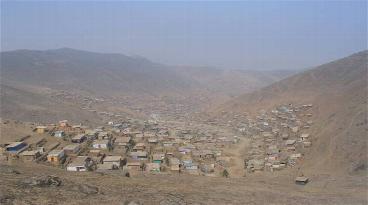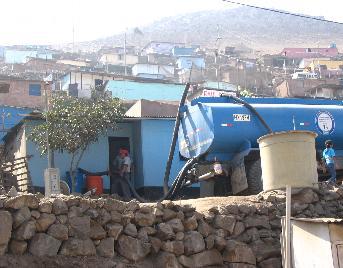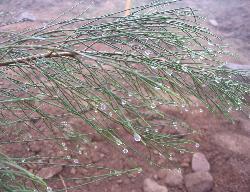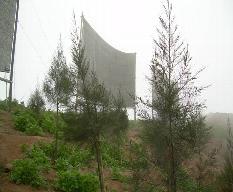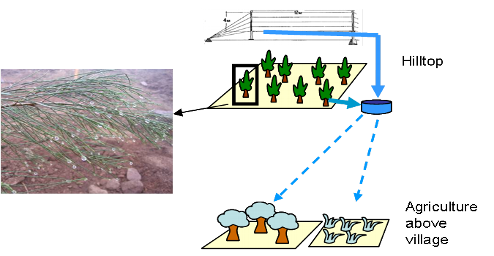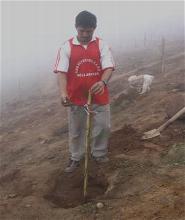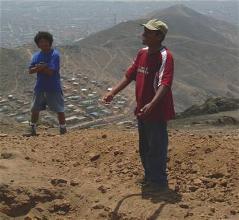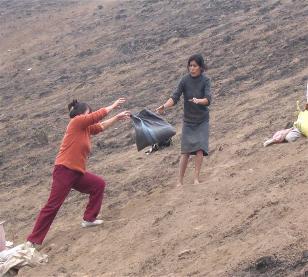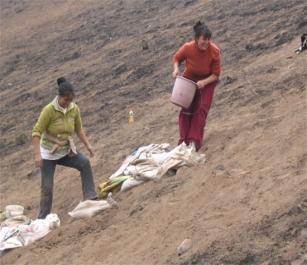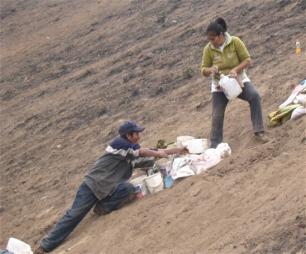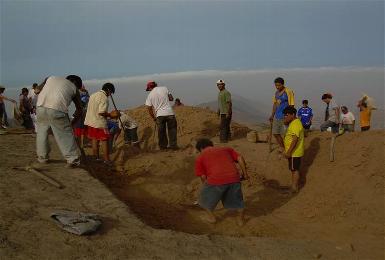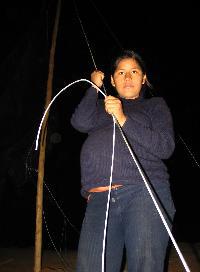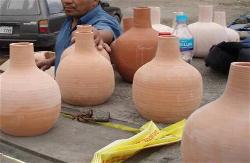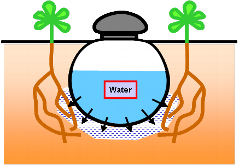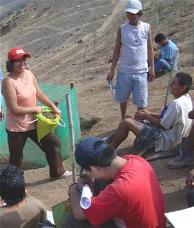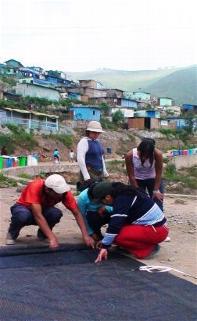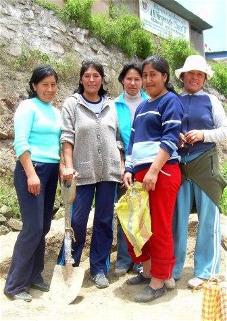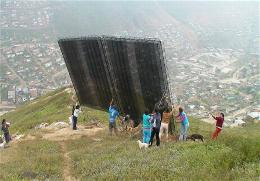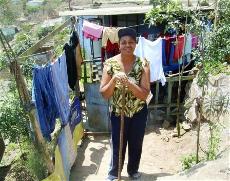The `Green Desert´ Project
By Anne Lummerich
It is wet here on one of the driest places on earth.
María Velasquez (32) has done the washing this morning. The sun had been out – the first time in weeks – but now the thick, wet fog has returned to Bellavista, a so-called young settlement at the outskirts of the capital Lima. This is where the poor live.
They came here from all over Peru, the Amazon, the Andes and the coastal provinces north and south of Lima – all in the hope for a better life, a chance for their children, a job. Unfortunately this hope is too often shattered once they have settled here. Jobs are very scarce in Lima; some men might find a job as bus driver assistant or temporary on construction sites. Some women sell food on the streets or work as domestic servant if they are lucky enough to have a letter of recommendation. María had one of those letters from her aunt. She was always a responsible and reliable worker. People in these settlements might be poor but that does not make them beggars or criminals. As Gerónimo Huayhua, the community leader of Quebrada Alta stresses; `we don´t want presents, we are willing to work hard for everything.´
By Anne Lummerich
It is wet here on one of the driest places on earth.
María Velasquez (32) has done the washing this morning. The sun had been out – the first time in weeks – but now the thick, wet fog has returned to Bellavista, a so-called young settlement at the outskirts of the capital Lima. This is where the poor live.
They came here from all over Peru, the Amazon, the Andes and the coastal provinces north and south of Lima – all in the hope for a better life, a chance for their children, a job. Unfortunately this hope is too often shattered once they have settled here. Jobs are very scarce in Lima; some men might find a job as bus driver assistant or temporary on construction sites. Some women sell food on the streets or work as domestic servant if they are lucky enough to have a letter of recommendation. María had one of those letters from her aunt. She was always a responsible and reliable worker. People in these settlements might be poor but that does not make them beggars or criminals. As Gerónimo Huayhua, the community leader of Quebrada Alta stresses; `we don´t want presents, we are willing to work hard for everything.´
Human settlement in the coastal hills
María says the first 5 months went well for her, she was even allowed to return to her children for the night. She is a single mother like so many women in Perú and does not receive any financial benefits from the government. When asked if the father of the children provides for them she only laughs.
Eventually Maria’s salary wasn’t paid on time anymore and then some months not at all. When she complained she was fired.
In her home village María Velasquez worked in agriculture but these traditional jobs are out of question here because the young settlements are not connected to the public water supply system.
María says the first 5 months went well for her, she was even allowed to return to her children for the night. She is a single mother like so many women in Perú and does not receive any financial benefits from the government. When asked if the father of the children provides for them she only laughs.
Eventually Maria’s salary wasn’t paid on time anymore and then some months not at all. When she complained she was fired.
In her home village María Velasquez worked in agriculture but these traditional jobs are out of question here because the young settlements are not connected to the public water supply system.
Water is delivered by trucks
The water that tends to be taken from illegal wells and is often contaminated arrives here in trucks for ten times the usual price. People are too poor to use this precious good for irrigation.
And there is no rain.
Peru´s coast sees only 10 mm of rain a year, last year there was moderate rain twice - for about 5 minutes. But there is fog, plenty of fog that covers the coast and the adjacent hills for about 6 months each year, from June to November. In these months every single object serves as an obstacle at which the fog water precipitates. The few remaining bushes and trees in the hills where Bellavista is situated are covered with droplets that fall to the ground and thus irrigate the plant - a phenomenon called self-irrigation. Around the bushes and trees other plants take advantage of this water supply.
The water that tends to be taken from illegal wells and is often contaminated arrives here in trucks for ten times the usual price. People are too poor to use this precious good for irrigation.
And there is no rain.
Peru´s coast sees only 10 mm of rain a year, last year there was moderate rain twice - for about 5 minutes. But there is fog, plenty of fog that covers the coast and the adjacent hills for about 6 months each year, from June to November. In these months every single object serves as an obstacle at which the fog water precipitates. The few remaining bushes and trees in the hills where Bellavista is situated are covered with droplets that fall to the ground and thus irrigate the plant - a phenomenon called self-irrigation. Around the bushes and trees other plants take advantage of this water supply.
Since June last year the trees have seen reinforcements being installed on the hilltop: First four fog collectors – consisting of two large poles with a 4x8m net between them – and later on 800 trees. Two biologists, Dr. Kai Tiedemann and Anne Lummerich, had started working in the area, putting their project idea `Green Desert´ into practice. The project was financed by the Global Exploration Fund, an initiative of Bayer and the National Geographic Society to explore sweet water sources. A private donation of 500 € made the purchase of saplings and fertilizer possible.
The Green Desert Project consists of two stages:
The Green Desert Project consists of two stages:
The Project `Green Desert´
Stage 1: First Winter season
Location: Hilltop
The fog water combed out by the fog collectors is conducted to water tanks and is used fort the irrigation of trees that were planted also on the hilltop.
Location: Hilltop
The fog water combed out by the fog collectors is conducted to water tanks and is used fort the irrigation of trees that were planted also on the hilltop.
Stage 2: Second Winter season
Location: Hilltop and village
The fog water combed out by the artificial natural fog collectors (trees) is conducted to water tanks and is used fort the irrigation of silvi- and agriculture above the village.
Surplus water can be led through a sandfilter and can be used for domestic use.
Location: Hilltop and village
The fog water combed out by the artificial natural fog collectors (trees) is conducted to water tanks and is used fort the irrigation of silvi- and agriculture above the village.
Surplus water can be led through a sandfilter and can be used for domestic use.
.
In the first stage fog collectors and water reservoirs are installed on the hilltop. Here we find the best conditions for a high water yield. Tree species which are adapted to aridity and are apt to comb fog are planted between the fog collectors and the water reservoirs. The fog water combed out by the fog collectors is conducted to the water tanks and is used fort the irrigation of the trees.
The second stage starts in the following winter season when the trees are no longer irrigated. Having reached a height of above 1 m they can irrigate themselves now. The taller ones have to do even more: They serve as natural fog-collectors. Channels or funnels are installed underneath them and a part of the water that falls down from their leaves and branches is conducted to the water tanks. So what happens to all the water that is no longer needed for the reforestation on the hilltop?
This water is meant to give the people in the villages the chance to work in their traditional jobs - that is in agriculture. Especially for the women agriculture is an opportunity to work close to their home and children. Also the connection to an economic incentive enhances the motivation to maintain the installations on the hilltop. The women have to pay a small part of the income they have by selling the products into a common fund. This money will be necessary for future repairs.
The first fog collectors were designed and put into practice in Chile by a Chilean-Canadian cooperation about 20 years ago. Although the system is simple, the true challenge is the sustainability - as in all development projects. So apart from creating the economic incentive explained above the people from the three villages are involved in every step of the project.
How it all started
Community leader Noe Neira Tocto was quite surprised when a `Gringo´ visited him one day in his modest hut in Bellavista. From previous studies Dr. Kai Tiedemann and Anne Lummerich knew the area was perfect for fog-collecting and were now looking for a community interested in participating. The hard working family father had already been mayor in his former village in the jungle. From an early age on he was politically active and he knew immediately that this was a chance for the settlement he represented. He just had one concern: `How much will it cost us? ´he asked.
It was that attitude that convinced the two Germans that they had found the right community. To the following reunion with the villagers he invited the adjacent two settlements Los Angeles and Quebrada Alta in order to form a stronger team.
In the first stage fog collectors and water reservoirs are installed on the hilltop. Here we find the best conditions for a high water yield. Tree species which are adapted to aridity and are apt to comb fog are planted between the fog collectors and the water reservoirs. The fog water combed out by the fog collectors is conducted to the water tanks and is used fort the irrigation of the trees.
The second stage starts in the following winter season when the trees are no longer irrigated. Having reached a height of above 1 m they can irrigate themselves now. The taller ones have to do even more: They serve as natural fog-collectors. Channels or funnels are installed underneath them and a part of the water that falls down from their leaves and branches is conducted to the water tanks. So what happens to all the water that is no longer needed for the reforestation on the hilltop?
This water is meant to give the people in the villages the chance to work in their traditional jobs - that is in agriculture. Especially for the women agriculture is an opportunity to work close to their home and children. Also the connection to an economic incentive enhances the motivation to maintain the installations on the hilltop. The women have to pay a small part of the income they have by selling the products into a common fund. This money will be necessary for future repairs.
The first fog collectors were designed and put into practice in Chile by a Chilean-Canadian cooperation about 20 years ago. Although the system is simple, the true challenge is the sustainability - as in all development projects. So apart from creating the economic incentive explained above the people from the three villages are involved in every step of the project.
How it all started
Community leader Noe Neira Tocto was quite surprised when a `Gringo´ visited him one day in his modest hut in Bellavista. From previous studies Dr. Kai Tiedemann and Anne Lummerich knew the area was perfect for fog-collecting and were now looking for a community interested in participating. The hard working family father had already been mayor in his former village in the jungle. From an early age on he was politically active and he knew immediately that this was a chance for the settlement he represented. He just had one concern: `How much will it cost us? ´he asked.
It was that attitude that convinced the two Germans that they had found the right community. To the following reunion with the villagers he invited the adjacent two settlements Los Angeles and Quebrada Alta in order to form a stronger team.
Noe Neira Tocto planting the first tree in the inauguration celebration and
Gerónimo Huayas holding a speech
Dr. Kai Tiedemann and Anne Lummerich presented their idea making clear that it would involve a lot of work for the communities. At the end of their presentation Noe Neira Tocto in his function as a natural leader shouted `So what will it be? Do we want to let them go?´
Fortunately they did not and work started the following Sunday.
Gerónimo had said they were willing to work for the development of their settlement and work they did.
Gerónimo Huayas holding a speech
Dr. Kai Tiedemann and Anne Lummerich presented their idea making clear that it would involve a lot of work for the communities. At the end of their presentation Noe Neira Tocto in his function as a natural leader shouted `So what will it be? Do we want to let them go?´
Fortunately they did not and work started the following Sunday.
Gerónimo had said they were willing to work for the development of their settlement and work they did.
The following weeks the material for the installations on the hilltop had to be carried uphill. Up to 150 people formed human chains to transport more than 10.000 kilo of sand and pebble to the project site – plus 2.000 bricks. Since there is hardly any fog in the summer months from January to May the fog water has to be stalled in water basins for the summer irrigation.
Professional bricklayer from Bellavista who received a wage from the fund for their work built two brick tanks with a capacity of 18.000 l each. In a great effort a huge water basin for 63.000 l was dug into the rocky ground, first in community work but later by four employed labourers from the villages because it was 8 hours 6 days a week job and the water basin was needed as quickly as possible because the water yield was even higher than expected.
Currently a second water reservoir is being build. Since the project isn´t financed by the Gloabl Exploration fond anymore and the newly founded organization is responsible for it now, people are working at the second reservoir without wages.
Professional bricklayer from Bellavista who received a wage from the fund for their work built two brick tanks with a capacity of 18.000 l each. In a great effort a huge water basin for 63.000 l was dug into the rocky ground, first in community work but later by four employed labourers from the villages because it was 8 hours 6 days a week job and the water basin was needed as quickly as possible because the water yield was even higher than expected.
Currently a second water reservoir is being build. Since the project isn´t financed by the Gloabl Exploration fond anymore and the newly founded organization is responsible for it now, people are working at the second reservoir without wages.
The second water reservoir is built in community work
The first morning after the first fog collector had been set up Tiedemann and Lummerich were quite nervous. It was very foggy and the two biologists thought if it does not work today it never will. They had worked with Javier and Ephraim until way after dark to put the fog collector up because the fog season had already started and they didn´t want to lose another day. Roxana a young woman from one of the villages had visited them and while helping to sow the net to the steel cables had chatted along, thus raising the spirit of the whole group. She was in her ninth month and it was amazing that she had climbed up the hill with her huge belly but the women are tough here, they even believe that physical work until the last minute helps to have a smooth delivery.
That morning Tiedemann and Lummerich hadn´t even reached the project sight when Javier spotted them. The young man is of a quite, reserved nature but today he talked excitedly. Although it was still early in the morning they had already emptied the 200 l barrel connected to the eaves underneath the fog collector and it was full again.
Hearing about fog collection is one thing but seeing that it actually works is another. That day was a good day, not only did they collect more than 600 l but Roxana also gave birth to a healthy girl.
The first morning after the first fog collector had been set up Tiedemann and Lummerich were quite nervous. It was very foggy and the two biologists thought if it does not work today it never will. They had worked with Javier and Ephraim until way after dark to put the fog collector up because the fog season had already started and they didn´t want to lose another day. Roxana a young woman from one of the villages had visited them and while helping to sow the net to the steel cables had chatted along, thus raising the spirit of the whole group. She was in her ninth month and it was amazing that she had climbed up the hill with her huge belly but the women are tough here, they even believe that physical work until the last minute helps to have a smooth delivery.
That morning Tiedemann and Lummerich hadn´t even reached the project sight when Javier spotted them. The young man is of a quite, reserved nature but today he talked excitedly. Although it was still early in the morning they had already emptied the 200 l barrel connected to the eaves underneath the fog collector and it was full again.
Hearing about fog collection is one thing but seeing that it actually works is another. That day was a good day, not only did they collect more than 600 l but Roxana also gave birth to a healthy girl.
The following months three more fog collectors were installed, the design following the Chilean model but experimenting with different materials. Meanwhile women work teams from the three villages took turns in planting about 800 trees. María Velasquez was in the Bellavista team. The work was hard sometimes; the holes for the trees had to be 40 cm deep and if she was unlucky her shovel hit rock which she had to break with the iron rod they all work with. Like all the women of her team she carried up to eight litre of water in each hand to the trees. The least favourite part of the reforestation sight was of course the one furthest away from the tanks. The trees here showed the slowest growth. Not only Maria can imagine why.
The brick tanks were overflowing in no time and the women used the water all winter and almost all summer to water the saplings.
450 clay pots could be purchased with the money from the fund. Clay pots present an innovative irrigation technique already applied by the Chinese and the Incas. The pots have pores and exude a defined amount of water daily – in this case 500 – 800 ml. They are dug right next to the tree into the ground thus avoiding water loss due to evaporation. The trees without clay pots were watered traditionally with bottles serving as water cans.
The brick tanks were overflowing in no time and the women used the water all winter and almost all summer to water the saplings.
450 clay pots could be purchased with the money from the fund. Clay pots present an innovative irrigation technique already applied by the Chinese and the Incas. The pots have pores and exude a defined amount of water daily – in this case 500 – 800 ml. They are dug right next to the tree into the ground thus avoiding water loss due to evaporation. The trees without clay pots were watered traditionally with bottles serving as water cans.
Clay pots
Exudation
The water tanks were empty one month before the beginning of the following fog season but all plants are adapted species to the extreme changes of climate we find in the coastal hills.
Due to the experimental character of the project – nobody could promise that all the objectives could be fulfilled – the fund paid for the daily work of the women.
The teams were organized by a female elected coordinator who was responsible for the composition of the team and for the execution of the given tasks. The coordinators also checked the installations for functionality and fixed little damages themselves and reported bigger damages to the two biologists or the workers from the villages.
At the beginning it was difficult to find women willing to take this responsibility because the women tend to be shy or not used to taking that role. The ones that finally volunteered developed into impressive leader figures, speaking out in community meetings and organizing workshops.
Due to the experimental character of the project – nobody could promise that all the objectives could be fulfilled – the fund paid for the daily work of the women.
The teams were organized by a female elected coordinator who was responsible for the composition of the team and for the execution of the given tasks. The coordinators also checked the installations for functionality and fixed little damages themselves and reported bigger damages to the two biologists or the workers from the villages.
At the beginning it was difficult to find women willing to take this responsibility because the women tend to be shy or not used to taking that role. The ones that finally volunteered developed into impressive leader figures, speaking out in community meetings and organizing workshops.
Coordinator Elizabeth doing a workshop about fertilizers
The winter of 2007 brought yet again a lot of fog. The four fog collectors exceeded once more all expectations and provided 100.000 l in less than eight weeks. Furthermore Tiedemann and Lummerich constructed full scale new pilot collectors based on the results of the small pilots. Those ones even brought a higher water yield – one of them more than three times the amount of water provided by the standard collectors.
Meanwhile the communities had continued with the faenas and had constructed `andenes´ right above the village. The andenes are terrasses that are used to make agriculture possible on slopes. These gardens were given to the women who have to pay a small monthly fee to a newly founded organization consisting of the female coordinators, the community leaders and an expert in fog collectors trained by the two biologists. The money is necessary to pay for future repairs of the installations and thus ensuring the sustainability of the project.
Above the family gardens about 400 trees were planted, mostly fruit trees that will render an income in the future.
Since there was much more water than the reservoirs could hold and the plants need, the idea came up to use the water as well as drinking water. This of course requires a treatment of the water. Currently the German team is trying to stretch the money provided by donations to Alimón to build the necessary installations.
In September the project was officially handed over to the organization of the villages. This took place in a solemn ceremony together with the entire population and representatives of the local government.
Everybody held speeches that day; all community leaders expressed their satisfaction and most of all their pride in the fruits of their labour. María Velasquez is content as well, she was able to harvest for the first time radish, beetroot and lettuce from her small garden - only the washing won´t dry today.
---------------------------------------------------------------------------------------------------------
The `lomas´ form an area of about 1.000 hectar with countless small settlements facing the same lack of water and lack of employment as Bellavista, Los Angeles and Quebrada Alta. Numerous communities have already expressed their great desire to participate in a replica of the project. Since the project `Desierto Verde´ has successfully shown that the fog collectors together with the trees provide enough water for family gardens and a plantation of fruit trees, the settlements beginning a replica of Green Desert would not only have to put their working hours into the project but will also cover a part of the costs for the material. There will be no more wages for the people irrigating the trees on the hilltop and the development of the trees is controlled after the first summer. Only if the trees have reached a certain height 50 % of their investment will be returned to the population.
This pilot project was financed until October 2007 by the Global Exploration Fund created by the National Geographic Society and the German Bayer corporation
but also received private donations via Alimón.
The Global Exploration Fund was founded 2005 in order to promote German scientists to develop innovative, simple and cheap ideas for sweet water sources and treatment. The project idea `Green Desert´ ,developed by Dr. Kai Tiedemann und Anne Lummerich, was chosen together with nine other project ideas
___________________________________________________________________________
Follow-up projects
In 2009 the successful pilot project was copied twice from neighbouring villages.
With help from the association Alimon, Virgen de Chapi B with its female community leader Magally de la Cruz received a donation from the German embassy in Lima. The money was used to pay for the newly designed fog collector `Eiffel´ (it is constructed out of iron bars), a water reservoir, clay pots for the irrigation of tara trees, a compost system (ecoalke@terra.com.pe) and three UDDTs (Urine Diverting Dry Toilets) for the kindergarden (www.rotaria.net). The association Alimon paid for the work of the maison. This project is currently shown on BBC World and www. rockhopper.tv
The winter of 2007 brought yet again a lot of fog. The four fog collectors exceeded once more all expectations and provided 100.000 l in less than eight weeks. Furthermore Tiedemann and Lummerich constructed full scale new pilot collectors based on the results of the small pilots. Those ones even brought a higher water yield – one of them more than three times the amount of water provided by the standard collectors.
Meanwhile the communities had continued with the faenas and had constructed `andenes´ right above the village. The andenes are terrasses that are used to make agriculture possible on slopes. These gardens were given to the women who have to pay a small monthly fee to a newly founded organization consisting of the female coordinators, the community leaders and an expert in fog collectors trained by the two biologists. The money is necessary to pay for future repairs of the installations and thus ensuring the sustainability of the project.
Above the family gardens about 400 trees were planted, mostly fruit trees that will render an income in the future.
Since there was much more water than the reservoirs could hold and the plants need, the idea came up to use the water as well as drinking water. This of course requires a treatment of the water. Currently the German team is trying to stretch the money provided by donations to Alimón to build the necessary installations.
In September the project was officially handed over to the organization of the villages. This took place in a solemn ceremony together with the entire population and representatives of the local government.
Everybody held speeches that day; all community leaders expressed their satisfaction and most of all their pride in the fruits of their labour. María Velasquez is content as well, she was able to harvest for the first time radish, beetroot and lettuce from her small garden - only the washing won´t dry today.
---------------------------------------------------------------------------------------------------------
The `lomas´ form an area of about 1.000 hectar with countless small settlements facing the same lack of water and lack of employment as Bellavista, Los Angeles and Quebrada Alta. Numerous communities have already expressed their great desire to participate in a replica of the project. Since the project `Desierto Verde´ has successfully shown that the fog collectors together with the trees provide enough water for family gardens and a plantation of fruit trees, the settlements beginning a replica of Green Desert would not only have to put their working hours into the project but will also cover a part of the costs for the material. There will be no more wages for the people irrigating the trees on the hilltop and the development of the trees is controlled after the first summer. Only if the trees have reached a certain height 50 % of their investment will be returned to the population.
This pilot project was financed until October 2007 by the Global Exploration Fund created by the National Geographic Society and the German Bayer corporation
but also received private donations via Alimón.
The Global Exploration Fund was founded 2005 in order to promote German scientists to develop innovative, simple and cheap ideas for sweet water sources and treatment. The project idea `Green Desert´ ,developed by Dr. Kai Tiedemann und Anne Lummerich, was chosen together with nine other project ideas
___________________________________________________________________________
Follow-up projects
In 2009 the successful pilot project was copied twice from neighbouring villages.
With help from the association Alimon, Virgen de Chapi B with its female community leader Magally de la Cruz received a donation from the German embassy in Lima. The money was used to pay for the newly designed fog collector `Eiffel´ (it is constructed out of iron bars), a water reservoir, clay pots for the irrigation of tara trees, a compost system (ecoalke@terra.com.pe) and three UDDTs (Urine Diverting Dry Toilets) for the kindergarden (www.rotaria.net). The association Alimon paid for the work of the maison. This project is currently shown on BBC World and www. rockhopper.tv
Community work in Virgen de Chapi B
Setting-up of the fog collector `Eiffel´ Magally de la Cruz
Also the village Quebrada Alta received their independent project with the largest `Eiffel´ fog collector built so far and a water reservoir. Alimon paid for this project with the help of generous donations made by the `Förderverein Lateinamerika´ (Münster).
Today - in 2012 - the trees of Bellavista are the only green patch in an area that is still being invaded. The water problem has not changed; there are just more people in need of water.
The projects have developed their own dynamics.
The community leaders of Bellavista managed to receive funding from private sources and politicians and kept on maintaining the installations until the end of 2010. There followed a period of negligence until the construction of a new road required large amounts of water and the collectors were repaired and put to use once more again. Since then the population and its ever energetic representatives have managed to raise the interest of national and international visitors and organizations.
The last time the installations were repaired was as recently as September 2011.
If you are as convinced of the Green Desert Project as the people living in extreme poverty in the hills at the outskirts of Lima then please help them with a donation to make their wish come true.
Donation Account Alimón Alimón e.V.
Kto.Nr.:107 155 5138 Tittardsfeld 102
BLZ: 390 500 00 52072 Aachen
Sparkasse Aachen
alummerich@alimon.org
ktiedemann@alimon.org
www.alimon.org
Also the village Quebrada Alta received their independent project with the largest `Eiffel´ fog collector built so far and a water reservoir. Alimon paid for this project with the help of generous donations made by the `Förderverein Lateinamerika´ (Münster).
Today - in 2012 - the trees of Bellavista are the only green patch in an area that is still being invaded. The water problem has not changed; there are just more people in need of water.
The projects have developed their own dynamics.
The community leaders of Bellavista managed to receive funding from private sources and politicians and kept on maintaining the installations until the end of 2010. There followed a period of negligence until the construction of a new road required large amounts of water and the collectors were repaired and put to use once more again. Since then the population and its ever energetic representatives have managed to raise the interest of national and international visitors and organizations.
The last time the installations were repaired was as recently as September 2011.
If you are as convinced of the Green Desert Project as the people living in extreme poverty in the hills at the outskirts of Lima then please help them with a donation to make their wish come true.
Donation Account Alimón Alimón e.V.
Kto.Nr.:107 155 5138 Tittardsfeld 102
BLZ: 390 500 00 52072 Aachen
Sparkasse Aachen
alummerich@alimon.org
ktiedemann@alimon.org
www.alimon.org


